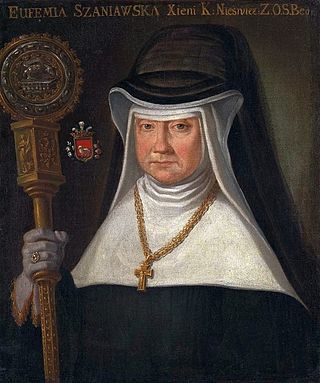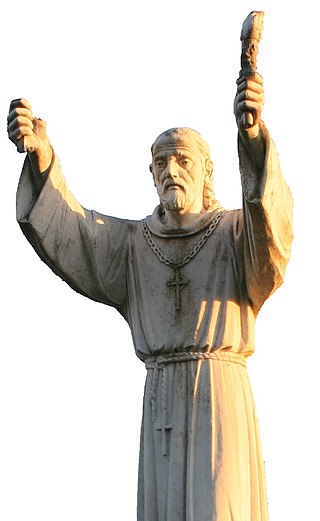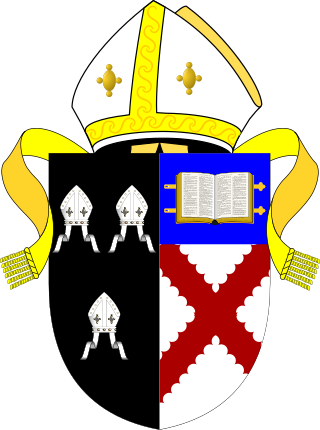Related Research Articles

An abbess is the female superior of a community of nuns in an abbey.

Saint Brigid of Kildare or Saint Brigid of Ireland is the patroness saint of Ireland, and one of its three national saints along with Patrick and Columba. According to medieval Irish hagiographies, she was an abbess who founded the important abbey of Kildare, as well as several other monasteries of nuns. There are few documented historical facts about her, and her hagiographies are mainly anecdotes and miracle tales, some of which are Christianisations of hero tales from Irish mythology. They say Brigid was the daughter of an Irish clan chief and an enslaved Christian woman, and was fostered in a druid's household before becoming a consecrated virgin. She is patroness of many things, including poetry, learning, healing, protection, blacksmithing, livestock and dairy production. In her honour, a perpetual fire was kept burning at Kildare for centuries.

Kildare is a town in County Kildare, Ireland. As of 2022, its population was 10,302, making it the 7th largest town in County Kildare. It is home to Kildare Cathedral, historically the site of an important abbey said to have been founded by Saint Brigid of Kildare in the 5th century. The Curragh lies east of the town.

April 17 - Eastern Orthodox liturgical calendar - April 19

A double monastery is a monastery combining separate communities of monks and of nuns, joined in one institution to share one church and other facilities. The practice is believed to have started in the East at the dawn of monasticism. It is considered more common in the monasticism of Eastern Christianity, where it is traceable to the 4th century. In the West the establishment of double monasteries became popular after St. Columbanus and sprang up in Gaul and in Anglo-Saxon England. Double monasteries were forbidden by the Second Council of Nicaea in 787, though it took many years for the decree to be enforced. Double monasteries were revived again after the 12th century in a significantly different way when a number of religious houses were established on this pattern among Benedictines and possibly the Dominicans. The 14th-century Bridgittines were purposely founded using this form of community.

May 2 - Eastern Orthodox Church calendar - May 4
Brehon is a term for a historical arbitration, mediative and judicial role in Gaelic culture. Brehons were part of the system of Early Irish law, which was also simply called "Brehon law". Brehons were judges, close in importance to the chiefs.

Clane is a town in County Kildare, Ireland, 35.4 km (22 mi) from Dublin. With a population of 8,152 in 2022, it is the ninth largest town in Kildare and the 66th largest in Ireland. The town is on the River Liffey. Clane gives its name to the associated townland, civil parish, electoral division and surrounding barony.

Finnian of Clonard – also Finian, Fionán or Fionnán in Irish; or Finianus and Finanus in its Latinised form (470–549) – was one of the early Irish monastic saints, who founded Clonard Abbey in modern-day County Meath. The Twelve Apostles of Ireland studied under him. Finnian of Clonard is considered one of the fathers of Irish monasticism.
St. Ultan of Ardbraccan, also known as Ultan the scribe was an Irish saint and Abbot-Bishop of Ardbraccan during the 7th century. He died c. 657 and his feast day is celebrated on 4 September.
County Kildare in the province of Leinster, Ireland, was first defined as a diocese in 1111, shired in 1297 and assumed its present borders in 1836. Its location in the Liffey basin on the main routes from Dublin to the south and west meant it was a valuable possession and important theatre of events throughout Irish history.

Oughterard is an ecclesiastical hilltop site, graveyard, townland, and formerly a parish, borough and royal manor in County Kildare, nowadays part of the community of Ardclough, close to the Dublin border. It is the burial place of Arthur Guinness.

Mél of Ardagh, also written Mel or Moel, was a 5th-century saint in Ireland who was a nephew of Saint Patrick. He was the son of Conis and Patrick's sister, Darerca. Saint Darerca was known as the "mother of saints" because most of her children entered religious life, many were later recognized as saints, and several of her sons became bishops.

Saint Conleth was an Irish hermit and metalworker, also said to have been a copyist and skilled illuminator of manuscripts. He is believed to have come from the Wicklow area.
There is archaeological evidence of insular monasticism as early as the mid 5th century, influenced by establishments in Gaul such as the monastery of Martin of Tours at Marmoutier, the abbey established by Honoratus at Lérins; the abbey of Mont-Saint-Michel; and that of Germanus at Auxerre. Many Irish monks studied at Candida Casa near Whithorn in what is now Galloway in Scotland.

The United Dioceses of Meath and Kildare is a diocese in the Church of Ireland located in the Republic of Ireland. The diocese is in the ecclesiastical province of Dublin. Alone of English and Irish bishops who are not also archbishops, the Bishop of Meath and Kildare is styled "The Most Reverend".

The Bishop of Kildare was an episcopal title which took its name after the town of Kildare in County Kildare, Ireland. The title is no longer in use by any of the main Christian churches having been united with other bishoprics. In the Roman Catholic Church, the title has been merged with that of the bishopric of Leighlin and is currently held by the Bishop of Kildare and Leighlin. In the Church of Ireland, the title has been merged with that of the bishopric of Meath and is currently held by the Bishop of Meath and Kildare.
Events from the 6th century in Ireland.

Kildare Cathedral, or St Brigid's Cathedral in Kildare, is one of two Church of Ireland cathedrals in the United Dioceses of Meath and Kildare. It is in the ecclesiastical province of Dublin. Originally a Catholic cathedral, it was built in the 13th century on the site of an important Celtic Christian abbey, which is said to have been founded by Saint Brigid in the 5th century. The site was taken over by the Protestant Church of Ireland following the Reformation. There is an Irish round tower in the cathedral grounds.

Drumlane is a townland situated near the village of Milltown, area 85.76 hectares, in County Cavan, Ireland. Drumlane is also the name of the civil parish in which the townland is situated. Saint Columba brought Christianity to Drumlane in 555, and Saint Máedóc of Ferns was the founder of an early Drumlane monastery. Saint Máedóc made the Connachta nobleman Faircheallaigh the first Abbot of Drumlane at the end of the sixth century and his Ó Faircheallaigh descendants became historically the Erenagh Abbots of Drumlane. The name Drumlane denotes the drumlin region of low hilly ribbed moraines formed over a limestone bedrock created by the movement of glacial ice and melt water during the last ice age. Several townlands in the neighbourhood are prefixed with the word 'Drum' ('Droim'), while several others are prefixed with the word 'Derry' ('Doire'), which is Irish for oak.
References
 This article incorporates text from a publication now in the public domain : Herbermann, Charles, ed. (1913). "School of Kildare". Catholic Encyclopedia . New York: Robert Appleton Company. cites:
This article incorporates text from a publication now in the public domain : Herbermann, Charles, ed. (1913). "School of Kildare". Catholic Encyclopedia . New York: Robert Appleton Company. cites: - STOKES, Lives of the Saints from the Book of Lismore (Oxford, 1890);